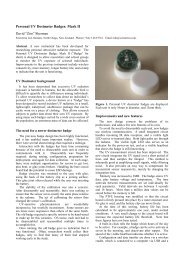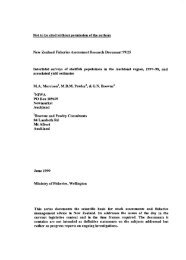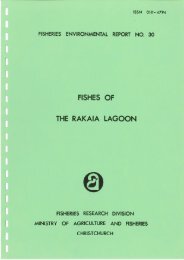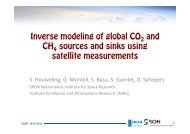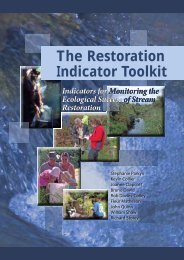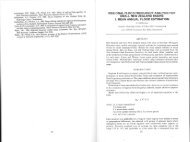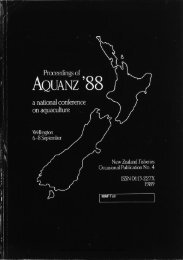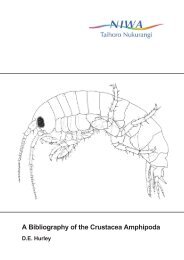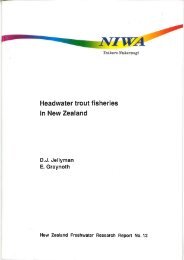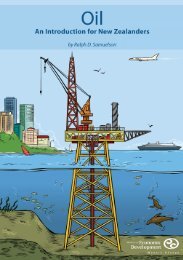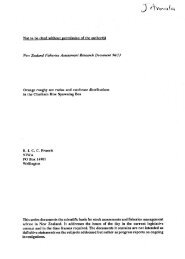WATER & SOIL - These are not the droids you are looking for.
WATER & SOIL - These are not the droids you are looking for.
WATER & SOIL - These are not the droids you are looking for.
You also want an ePaper? Increase the reach of your titles
YUMPU automatically turns print PDFs into web optimized ePapers that Google loves.
5 Application<br />
5.1 lntroduction<br />
This chapter collates <strong>the</strong> applicable results and findings<br />
from <strong>the</strong> preceding two chapters and <strong>for</strong>mulates <strong>the</strong>m into<br />
what is subsequently reierred to as <strong>the</strong> Regional Flood Estimation<br />
(RFE) method. Rules <strong>for</strong> <strong>the</strong> applicability of <strong>the</strong><br />
RFE method <strong>are</strong> given, a design strategy <strong>for</strong> estimating <strong>the</strong><br />
T-year flood peak is suggested and a number of examples<br />
<strong>are</strong> given which demonstrate <strong>the</strong> use of <strong>the</strong> method.<br />
The RFE method is intended as a procedure to be used<br />
<strong>for</strong> estimating design flood magnitude in situations where<br />
insufficient flood records <strong>are</strong> available <strong>for</strong> conventional<br />
fiequency analysis. It is one of several design flood estimation<br />
methods in such situations and o<strong>the</strong>r methods should<br />
be used and comp<strong>are</strong>d with it. It has been derived from<br />
tlood records by:<br />
(¡) defining regional flood frequency curves of Q1/Q vs<br />
T, where Q1 is a design flood with return period T and<br />
Q is <strong>the</strong> mean annual flood; and<br />
(ii) developing a set of equations <strong>for</strong> estimating Q based<br />
on catchment <strong>are</strong>a and measures of rainfall.<br />
A comparison with Technical Memorandum No' 6l<br />
(TM 6l) is reported in Appendix E.<br />
5.2 Applicability<br />
The applicability of <strong>the</strong> RFE method is necessarily constrained<br />
by <strong>the</strong> restrictions that were applied to <strong>the</strong> data<br />
used in deriving <strong>the</strong> method. The following constraints<br />
<strong>the</strong>re<strong>for</strong>e apply.<br />
The method should only be used <strong>for</strong> rural catchments.<br />
The method should <strong>not</strong> be applied to catchments in<br />
which snowmelt, glaciers, springs, lake storage or<br />
ponding significantly affect <strong>the</strong> flood peak characteristics.<br />
The ranges of catchment <strong>are</strong>as <strong>for</strong> which <strong>the</strong> regional<br />
flood frequency curves and <strong>the</strong> regional mean annual<br />
flood equations were derived <strong>are</strong> listed in Table 5.1.<br />
<strong>These</strong> <strong>are</strong> a guide <strong>for</strong> <strong>the</strong> size of catchment to which<br />
<strong>the</strong> method should be applied.<br />
Because of <strong>the</strong> subjective and ra<strong>the</strong>r broad definition of<br />
regional boundaries, it is suggested that, <strong>for</strong> catchments<br />
near boundaries, floöd frequency curves and annual flood<br />
equations <strong>for</strong> <strong>the</strong> regions ei<strong>the</strong>r side of <strong>the</strong> lines.should be<br />
used in estimating Q1/Q and Q respectively. As in a design<br />
situation where different methods yield different estimates,<br />
<strong>the</strong> different Q1/Q and Q estimates <strong>the</strong>n need to be 'comp<strong>are</strong>d',<br />
i.e., <strong>the</strong> merits of each should be assessed and <strong>the</strong><br />
choice of an estimate should be made after a rationalisation<br />
of <strong>the</strong> relevant facts. Alternatively, a belief probability can<br />
be attached to each estimate and <strong>the</strong>ir expectation calculated,<br />
which is akin to taking a weighted average of <strong>the</strong> estimates.<br />
5.3 Design Strategy<br />
5.3.1 General<br />
The strategy <strong>for</strong> <strong>the</strong> use of <strong>the</strong> RFE method in design is<br />
dependent on two main factors: N, <strong>the</strong> length in years of<br />
<strong>the</strong> flood record if a record is available, and T, <strong>the</strong> design<br />
return period. The influence of <strong>the</strong>se factors on <strong>the</strong> two<br />
parts of <strong>the</strong> RFE method (i.e. <strong>the</strong> regional mean annual<br />
flood equations and <strong>the</strong> regional flood frequency curves) is<br />
explained in <strong>the</strong> two following sections and summarised in<br />
Figure 5.1 .<br />
5.3.2 Estimat¡on of O<br />
(¡) N(Nu<br />
Where <strong>the</strong>re is a flood record and its length N is less than<br />
Nu, which is <strong>the</strong><br />
is equivalent to <strong>the</strong><br />
prãcision of <strong>the</strong> r<br />
on (see Table 4. l2)'<br />
<strong>the</strong> mean annual<br />
imated from <strong>the</strong> regional<br />
equation and <strong>the</strong> available flood record. In applying<br />
<strong>the</strong> equation it is particularly important to estimate values<br />
<strong>for</strong> <strong>the</strong> rainfall variables 1224 and MARAIN in a similar<br />
manner and from <strong>the</strong> same data base as used in <strong>the</strong> equation's<br />
derivation. Specific points to <strong>not</strong>e in estimating<br />
values <strong>for</strong> 1224 and MARAIN <strong>are</strong> outlined below.<br />
1224 Estimates ol <strong>the</strong> 1224 rainfall intensity statistic used<br />
in deriving <strong>the</strong> equations <strong>for</strong> Q were obtained by taking <strong>the</strong><br />
arithmetic mean of <strong>the</strong> 2-year 24-hour data listed by Robertson<br />
(1963, Table 9) <strong>for</strong> rainfall stations located within,<br />
or near to, <strong>the</strong> catchment concerned. Estirrates can be<br />
made from <strong>the</strong> tabular results (Appendix D) obtained by<br />
Tomlinson (1980) in a recent revision of <strong>the</strong> frequency an-<br />
Table 5.1 Ranges of catchment <strong>are</strong>as used to derive regional flood frequency curves and mean annual<br />
flood equations.<br />
Flood frequency<br />
reglon<br />
(Fis. 3.6, 3.7)<br />
Combined N.l.<br />
West Coast<br />
Central Bay of PlentY<br />
N.l. East Coast<br />
Central Hawke's Bay<br />
S.l. West Coast<br />
S.l. East Coast<br />
South Canterbury<br />
Otagoi Southland<br />
Catchment <strong>are</strong>a<br />
(km2)<br />
(Table 3.2)<br />
fntn max<br />
2.5 6643<br />
28.2 2893<br />
171 2370<br />
24.3 2424<br />
48 6350<br />
74.6 3430<br />
22.4 899)<br />
lo9<br />
)<br />
18321<br />
Mean annual flood<br />
feglon<br />
(Fig.4 7,4.1O)<br />
Northland/Coromandel/<br />
East Cape<br />
West Coast<br />
Manawatu/WairaraPa/<br />
Wellington<br />
Pumice<br />
Northland/Coromandel/<br />
East Cape<br />
East Coast<br />
West Coast<br />
lnland Marlborough/<br />
Canterbury<br />
East Coast<br />
(Mackenzie, lnland<br />
(Otago, Southland<br />
(East Coast<br />
Water & soil technical publication no. 20 (1982)<br />
Catchment <strong>are</strong>a<br />
(km')<br />
(Tables 4.1, 4.2)<br />
min max<br />
o4 640<br />
3.1 1075<br />
9.4 734<br />
2.6 534<br />
o.4 640<br />
o5<br />
997<br />
4.O 998<br />
o.2 1070<br />
2.2 464<br />
36.8 1088<br />
2.2 464



